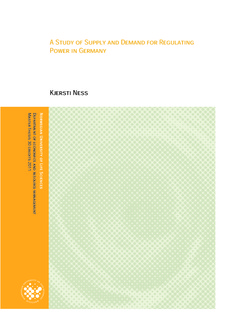| dc.contributor.author | Ness, Kjersti | |
| dc.date.accessioned | 2012-04-27T12:01:18Z | |
| dc.date.available | 2012-04-27T12:01:18Z | |
| dc.date.issued | 2012-04-27 | |
| dc.identifier.uri | http://hdl.handle.net/11250/187307 | |
| dc.description | A thesis that aims to identify a supply and demand function of regulating power in Germany, to investigate the factors that influence this market. The main goal is to see what will happen if large scale intermittent power are implemented in the market. | no_NO |
| dc.description.abstract | “Norway; the green battery of Europe” - This is a common conception among participants in the energy market nowadays where the value of flexible Norwegian hydropower is heavily discussed. This thesis is a contribution to the valuation of Norwegian flexibility, and the market of balancing power in Germany has the main focus. The focus of this thesis is to find a
supply and demand curve of balancing power, more precisely minute reserve in Germany. This thesis aims to identify a supply and demand function for the regulating market, and investigate if increased solar and wind power production leads to increased need for regulating power. Data of both upward and downward regulation from two TSOs in Germany
from May 2009 to December 2010 were collected and analysed. A model was developed with simultaneous equations using the method of “two stage least squares”. It proved to be difficult
to find a good model for this problem due to a number of reasons. The complexity of the
energy markets, especially the balancing market, and the conflict of interest which arise when suppliers of regulating power both consume and produce electricity, results in difficulties in estimating the supply and demand functions. I used a simple model to investigate the effects
of increased solar and wind power production. In this model, increased wind and solar power production leads to an increase in both price and quantity for upward regulation. For downward regulation an increase in solar and wind power production gave an increase in
quantity of downward regulation and a decrease in price. These results imply that increased intermittent power production leads to an increased need for regulating power. The structural model I found based upon supply and demand is not proper to use for economic analysis due to the difficulties of finding relevant and valid instruments. This means that it is
difficult to identify the price effect on the demand side. However, to my knowledge, there are limited or no previous estimates of supply and demand curves by this method, and it is important to note that it may be very difficult to estimate such a model. The main result in this thesis is that it may be impossible to estimate a model for supply and demand in this market. | no_NO |
| dc.language.iso | eng | no_NO |
| dc.publisher | Norwegian University of Life Sciences, Ås | |
| dc.subject | econometrics | no_NO |
| dc.subject | energy | no_NO |
| dc.subject | power | no_NO |
| dc.subject | economics | no_NO |
| dc.subject | hydropower | no_NO |
| dc.subject | supply and demand | no_NO |
| dc.subject | Germany | no_NO |
| dc.subject | Norway | no_NO |
| dc.title | A study of supply and demand for regulating power in Germany | no_NO |
| dc.type | Master thesis | no_NO |
| dc.subject.nsi | VDP::Social science: 200::Economics: 210::Econometrics: 214 | no_NO |
| dc.source.pagenumber | 66 | no_NO |
